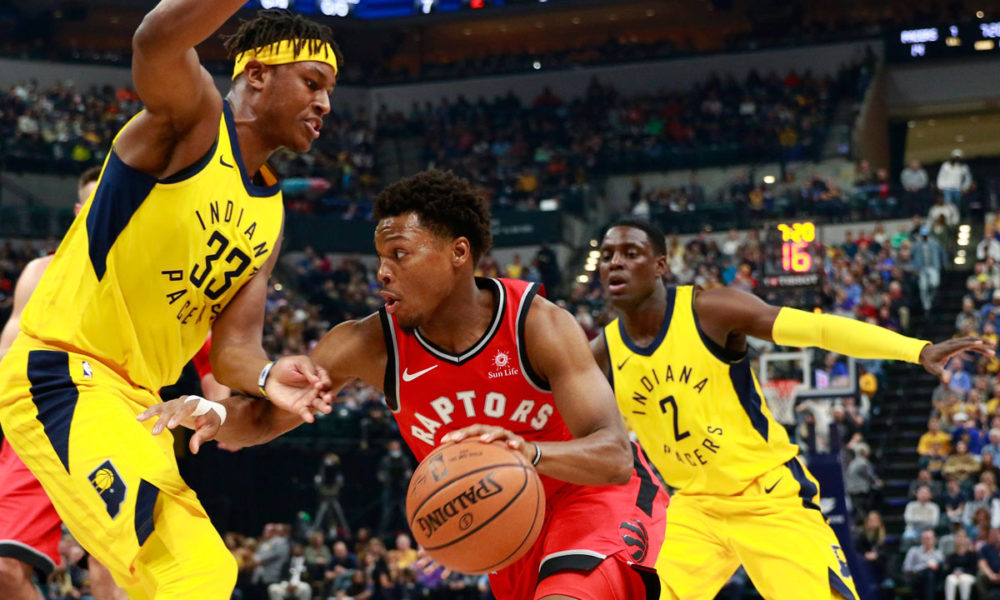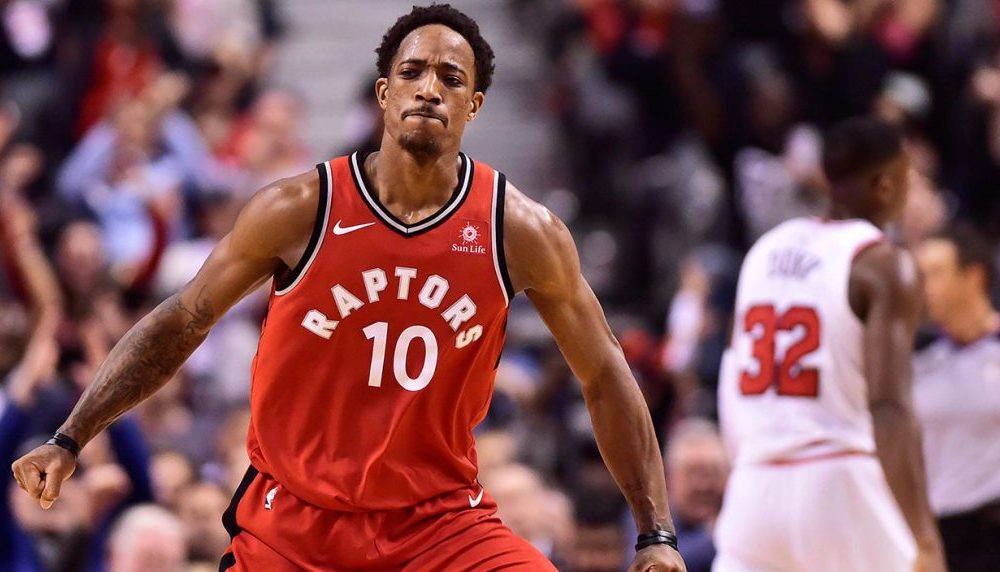It hasn’t been an easy stretch for the Toronto Raptors recently, and it’s got fans gnawing their fingernails to nubbins as they either try to explain away or get upset about the losses. Thankfully, this ruckus was quelled somewhat on Wednesday night, when the Raptors welcomed the rival Boston Celtics into their building and delivered them a punch to the jaw that will likely see Toronto finishing the season with the top spot in the Eastern Conference.
From all across Canada, you could hear the collective sigh of relief, even if for one night.
That same exhale hasn’t come for C.J. Miles, who’s been struggling mightily since the All-Star break, and found himself doing so yet again against Boston as he put up just three points on 1–5 shooting from three-point range.
Prior to the break, the veteran marksman (6.5 of his 8.5 shots are coming from deep this season) was shooting 38.9 per cent from three. Since then, it’s dropped to 32.1 per cent. Even worse, over the Raptors’ tough stretch (which began with Oklahoma City on March 18th), he’s shooting a brutal 22.9 per cent while taking closer to seven attempts per game.
Miles’ struggles have really hurt the bench unit, who rely fairly heavily on him to make shots. When he doesn’t, the group often finds it difficult to score and will have strings of minutes where they just seem to be unable to put the ball in the bucket. Adding to that, if Miles isn’t scoring, his value falls off supremely, as he isn’t a great defender.
Since March 18th, the Bench Mob has a net rating of -10, down significantly from their overall season net rating of 18.9. But plug in Norman Powell instead of Miles with the same group, and the net rating skyrockets to 16.8. Do the same with Kyle Lowry in place of Miles, and the result is an even better 24.3 net rating.
So yes, Miles is having a tough go—but why?
The numbers would indicate that Miles has simply fallen off. Every conceivable metric and statistic tells the same story: Miles is shooting the exact same shots, he just isn’t making them anymore. For example, Miles takes 5.6 of his threes off of catch-and-shoots, and 68.5 per cent of them without a single dribble. These numbers haven’t shifted since March 18th or since the All-Star break, but his percentage of makes has decreased dramatically (e.g. Miles shot 40.2 per cent off of no dribble shots pre-All-Star, and is shooting 30.8 per cent since).
Similarly, opposing defenses haven’t been playing him any better than usual and forcing more contested looks—before the All-Star break, Miles was getting 2.5 open threes per game and shooting 40.5 per cent on them. Since then, he’s getting the exact same amount of open looks and hitting only 26.7 per cent—and since March 18th he’s getting 2.7 open looks while draining 12.5 per cent of them.
But we know Miles isn’t a player returning to earth. He’s a career 36.2 per cent three-point shooter! And while he is just missing good looks sometimes, this stretch since March 18th, at least, is also about how he’s getting his shots, and how he’s taking them.
More than any other type of player, three-point specialists require rhythm for their game to thrive. For Miles, that means movement. Not just movement to get open for a look, but movement into the shot itself. This comes easiest when Miles is getting one of two things: A look off of a curl or a look out of a high screen on the perimeter.
Starting on the weak side, Miles will sling around to the baseline and receive an off-ball screen as a hand-off occurs up top. He’ll continue on, bolting along the baseline as his man is slowed by the screener. Curling up to the perimeter, he’ll catch the ball as he turns, already in movement, shooting in a clean, controlled, single motion.
As for the high screens, Miles is forced into motion with or without the ball. If he has the ball, he will wait for the screen, do a mini-curl around the screener, and immediately spring into his jumper once he sees daylight. If he doesn’t have the ball, he’ll zip around the screener, catch, and fire.
Since March 18th, these actions are few and far between. Miles is still getting open looks, but instead of getting them from curls and screens, he’s getting them by simply floating around the perimeter as penetrators will find him (or another teammate who will pass to him) on kick-outs. This sounds fine, but the result is Miles catching the ball and shooting without much movement, and making less of his attempts as a result.
It’s also become a bit of a trend recently for Miles to catch the ball deep outside the arc, which means that he’s technically open, by statistical standards, because he has a certain amount of space from his man, but those open shots aren’t equal to open shots closer to the three-point line, and much of the time the misses from those spots clank off the front of the rim, meaning Miles was too far out to give the right amount of oomph to score. Not good shots for a struggling shooter.
Something else worth noting: Miles is a fantastic spot-up shooter, which seems to disapprove this notion that he needs to be moving to get a good rhythm going and for his shot to fall. He sits in the 92nd percentile in spot-up shooting this season, creating 1.25 points per possession from those shots. However, the shots Miles takes from a stagnant position are almost always wide-open (meaning the nearest defender is at least six feet away) or from the corners, and those are areas he hasn’t faltered in as he has with his other looks. In fact, even since March 18th while he’s been most abysmal, he’s still shooting 38.9 per cent on wide-open attempts.
Of course, a player only gets so many wide-open looks per game, and while Miles sees his fair share, it’s the rest of his looks that are suffering—the ones that require movement.
Moving from how he gets his shots to how he takes them, Miles is typically quite good at manufacturing rhythm out of his own movement even without actions being run for him. When he sees a potential opportunity coming, he raises his hands and begins to slip up or down the side of the arc so that when the ball finds him, he’s already in motion. The entire thing is fluid, and there aren’t any pauses or hesitations that can disrupt him.
Lately, Miles has changed things up just slightly. He’s been moving less on a lot of incoming passes (or with less conviction), and while he still will hop into the catch, the motion isn’t as fluid as before. Instead, what Miles ends up doing is catching the ball, pausing for just an instant, and then firing his shot. Or, other times, he catches with very little movement, and fires right away. The result is his rhythm, his flow of motion, being disturbed.
The good news in all of this is that, eventually, the law of averages will come into play. Miles is a much better shooter than he’s showing right now, but it wouldn’t hurt the Raptors to try running him some more consistent actions, and it wouldn’t hurt for Miles himself to perhaps take a breath, and remember what makes him such a potent three-point threat.
Besides, it might be better for Miles to have his slump now, and get it out of the way before the playoffs begin. Because the reality is this: At some point soon, he’s going to go off. And when he does, we can all exhale.



